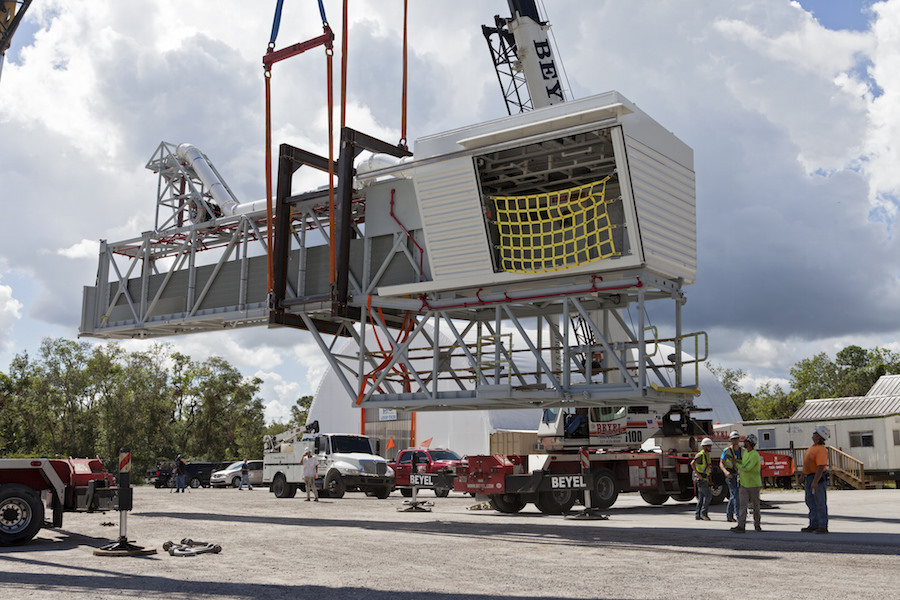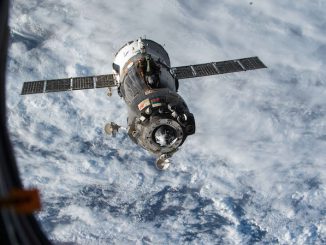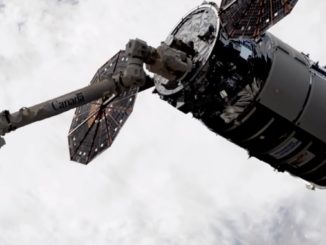
Construction crews at NASA’s Kennedy Space Center are making steady progress outfitting the Space Launch System’s mobile platform with umbilical connections and access arms, and the walkway for astronauts to board the rocket is the most recent arrival at the Florida spaceport.
The mobile launch platform was originally built for NASA’s Constellation program conceived under the George W. Bush administration, in which astronauts would have launched on missions to the International Space Station, and eventually the moon, atop Ares 1 rockets derived from the space shuttle’s solid rocket boosters.
The towering structure stands nearly 400 feet tall and weighs 10.5 million pounds, and it was finished in 2010, the same year the Obama administration canceled the Constellation moon program after development costs soared.
The Obama White House and Congress agreed on a new path for NASA’s human spaceflight program, which included turning over responsibility for missions to Earth orbit to the commercial sector and designing and building the SLS heavy-lift rocket, a huge launcher powered by surplus shuttle-era liquid-fueled engines and solid rocket boosters.
The SLS is being built to transport astronauts into deep space, perhaps initially to a miniature space station near the moon, then to the lunar surface and on to Mars, according to NASA’s long-term plans. Crews fastened inside Orion capsules will blast off atop the Space Launch System.
NASA decided to modify the Ares rocket’s mobile launch platform for the SLS, upgrades that included cutting new holes in the structure’s two-story-tall base to accommodate the heavy-lift launcher’s core stage engines and twin side-mounted boosters, instead of the single-stick Ares 1 configuration.

Those large-scale structural changes are now largely complete, and work to install swing arms to the platform’s tower is now underway.
The walkway for astronauts to board the Orion crew capsule is next to be lifted into place on the mobile launch platform. The crew access arm arrived at the Kennedy Space Center earlier this month, where it is being stored in a parking lot until it moves to mobile launch platform’s worksite just north of the iconic Vehicle Assembly Building.
A crane will soon hoist the crew access arm to the tower’s 274-foot-level, where crews will connect it to the structure with a hinge. The appendage includes a white room, where astronauts will prepare to enter the Orion capsule’s hatch.
Earlier this year, construction crews installed the Orion Service Module Umbilical, which will connect the spacecraft’s propulsion and power section with ground supplies of electricity and liquid coolant. A swing arm with the SLS Core Stage Forward Skirt Umbilical — designed to provide conditioned air and gaseous nitrogen to the upper part of the first stage — was attached to the tower’s 220-foot-level in June.
The platform’s Aft Skirt Electrical and Pneumatic Umbilicals have also been added to the mobile launch platform where the solid rocket boosters will be located, and workers earlier this month hoisted the SLS Core Stage Inter-tank Umbilical for a fit check. It will be permanently installed in the coming months to provide connections to the first stage between its cryogenic liquid hydrogen and liquid oxygen propellant tanks.

The inter-tank umbilical’s primary function is to vent excess gaseous hydrogen from the rocket’s core stage, NASA said, along with providing conditioned air, high-pressure gases, power and data to the core stage.
Items still to be added to the mobile launch platform include the Vertical Stabilizer, which will help protect the 322-foot-tall (98-meter) rocket from winds. An umbilical line to feed propellants into the SLS upper stage — called the Interim Cryogenic Propulsion Stage — is also planned for installation.
The first SLS test flight, known as Exploration Mission-1, will use an upper stage originally designed for United Launch Alliance’s Delta 4 rocket with a single RL10 engine.
Construction crews Tail Service Masts will also be fitted to the platform’s base to route cryogenic propellants to the SLS first stage.
Engineers are testing the umbilical connections at a separate KSC facility to demonstrate how the lines will disconnect and pull back from the SLS at or just before liftoff.
Once the mobile launch platform is ready, engineers will move it inside the VAB for further testing.

Exploration Mission-1’s target launch date was expected to occur this year when the SLS program was announced in 2011, but is now scheduled no sooner than late 2019. NASA is expected to announce a more specific timeframe for the flight in the coming weeks.
The test flight will be the first for the Space Launch System, and the second for the Orion spacecraft after a shakedown cruise in Earth orbit in December 2014.
A rocket of SLS’ size is required to send the Orion spacecraft to more distant destinations, and the flight plan for EM-1 calls for the capsule to fly into a high-altitude orbit around the moon for a planned three-week mission.
EM-1 will not carry any astronauts. That capability will debut with Exploration Mission-2 in the early 2020s, after engineers complete development of Orion’s life support system and cockpit controls, along with a more powerful four-engine upper stage for the Space Launch System.
The upgraded SLS will need a redesigned mobile launch platform because it will stand around 40 feet (13 meters) taller than the rocket slated to fly on EM-1. Construction crews will need to fabricate new umbilicals and reposition others on the tower, a process expected to take a couple of years.
Meanwhile, preparations for the inaugural Space Launch System flight are also progressing inside the Vehicle Assembly Building and at launch pad 39B.
Ten new work platforms were installed inside the VAB high bay that will house the SLS during its build-up and assembly, replacing equipment that was tailored for the space shuttle.

At pad 39B, construction workers installed the last of about 96,000 heat-resistant bricks inside the north side of the flame trench in May. The bricks are built to withstand temperatures of up to 2,000 degrees Fahrenheit from exhaust generated by the SLS core stage engines and solid rocket boosters.
Current work at pad 39B involves the positioning of a new flame deflector under the launch mount to redirect all of the rocket’s exhaust to the north side of the pad. That is a change from the pad’s shuttle-era configuration, in which exhaust was routed to both the north and the south.
Once the Space Launch System is fully stacked inside the VAB, one of NASA’s Apollo-era crawler-transporters will transfer it to pad 39B for final countdown preparations.
Email the author.
Follow Stephen Clark on Twitter: @StephenClark1.



